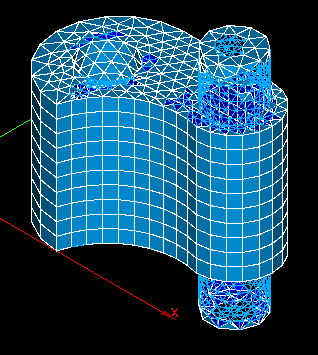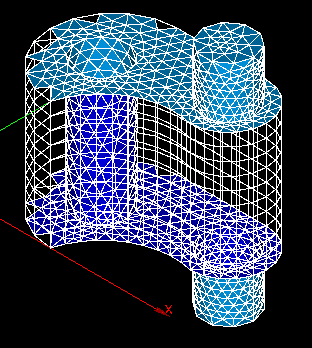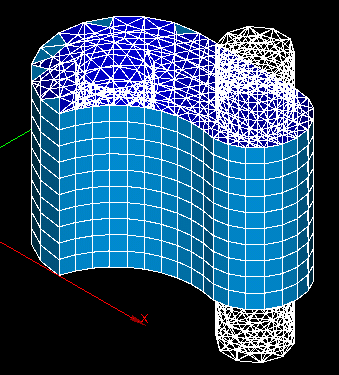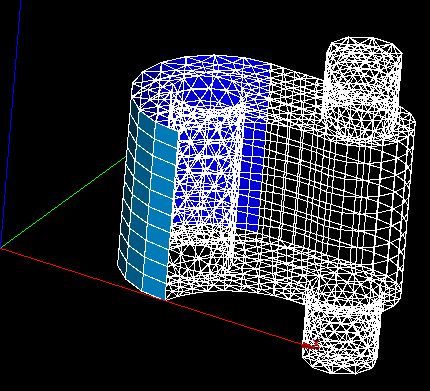
# Attention! This script has been written using the old approach basing on direct usage of SMESH idl interface.
# For the moment smesh package doesn't provide methods to create a standalone group.
# In the next SALOME version the scripts will be updated to use only the commands from smesh package.
import SMESH
import SMESH_mechanic
smesh = SMESH_mechanic.smesh
mesh = SMESH_mechanic.mesh
salome = SMESH_mechanic.salome
# Get ids of all faces with area > 100
aFilterMgr = smesh.CreateFilterManager()
aFunctor = aFilterMgr.CreateArea()
aPredicate = aFilterMgr.CreateMoreThan()
aPredicate.SetNumFunctor( aFunctor )
aPredicate.SetMargin( 100 )
aFilter = aFilterMgr.CreateFilter()
aFilter.SetPredicate( aPredicate )
anIds = aFilter.GetElementsId( mesh )
# create a group consisting of faces with area > 100
aGroup = mesh.CreateGroup( SMESH.FACE, "Area > 100" )
aGroup.Add( anIds )
salome.sg.updateObjBrowser(1)

import salome
import geompy
import smesh
# create a box
box = geompy.MakeBox(0., 0., 0., 100., 100., 100.)
geompy.addToStudy(box, "box")
# add the first face of the box to the study
subShapeList = geompy.SubShapeAll(box, geompy.ShapeType["FACE"])
face = subShapeList[0]
geompy.addToStudyInFather(box, face, "face 1")
# create group of edges on the face
aGeomGroupE = geompy.CreateGroup(face, geompy.ShapeType["EDGE"])
geompy.AddObject(aGeomGroupE, 3)
geompy.AddObject(aGeomGroupE, 6)
geompy.AddObject(aGeomGroupE, 8)
geompy.AddObject(aGeomGroupE, 10)
geompy.addToStudyInFather(face, aGeomGroupE, "Group of Edges")
# create quadrangle 2D mesh on the box
quadra = smesh.Mesh(box, "Box : quadrangle 2D mesh")
algo1D = quadra.Segment()
quadra.Quadrangle()
algo1D.NumberOfSegments(7)
# compute the mesh
quadra.Compute()
# create SMESH group on the face with name "SMESHGroup1"
aSmeshGroup1 = quadra.Group(face, "SMESHGroup1")
# create SMESH group on <aGeomGroupE> with default name
aSmeshGroup2 = quadra.Group(aGeomGroupE)
salome.sg.updateObjBrowser(1)
# Attention! This script has been written using the old approach basing on direct usage of SMESH idl interface.
# For the moment smesh package doesn't provide methods to edit a group.
# In the next SALOME version the scripts will be updated to use only the commands from smesh package.
import SMESH
import SMESH_mechanic
smesh = SMESH_mechanic.smesh
mesh = SMESH_mechanic.mesh
salome = SMESH_mechanic.salome
# Get ids of all faces with area > 35
aFilterMgr = smesh.CreateFilterManager()
aFunctor = aFilterMgr.CreateArea()
aPredicate = aFilterMgr.CreateMoreThan()
aPredicate.SetNumFunctor(aFunctor)
aPredicate.SetMargin(35.)
aFilter = aFilterMgr.CreateFilter()
aFilter.SetPredicate(aPredicate)
anIds = aFilter.GetElementsId(mesh)
print "Criterion: Area > 35, Nb = ", len(anIds)
# create a group by adding elements with area > 35
aGroup = mesh.CreateGroup(SMESH.FACE, "Area > 35")
aGroup.Add(anIds)
# Get ids of all faces with area > 40
aFunctor = aFilterMgr.CreateArea()
aPredicate = aFilterMgr.CreateMoreThan()
aPredicate.SetNumFunctor(aFunctor)
aPredicate.SetMargin(40.)
aFilter = aFilterMgr.CreateFilter()
aFilter.SetPredicate(aPredicate)
anIds = aFilter.GetElementsId(mesh)
print "Criterion: Area > 40, Nb = ", len(anIds)
# create a group of elements with area [35; 40] by removing elements with area > 40 from group aGroup
aGroup.Remove(anIds)
# print the result
aGroupElemIDs = aGroup.GetListOfID()
print "Criterion: 35 < Area < 40, Nb = ", len(aGroupElemIDs)
j = 1
for i in range(len(aGroupElemIDs)):
if j > 20: j = 1; print ""
print aGroupElemIDs[i],
j = j + 1
pass
print ""
salome.sg.updateObjBrowser(1)
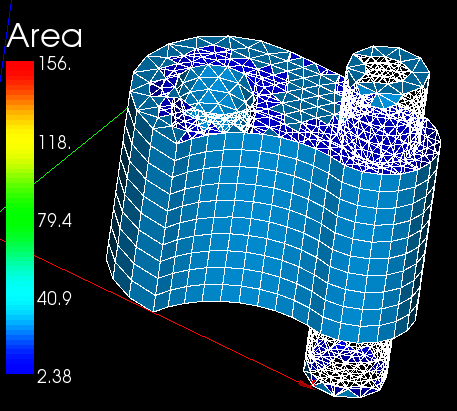

# Attention! This script has been written using the old approach basing on direct usage of SMESH idl interface.
# For the moment smesh package doesn't provide methods to create a union of two groups.
# In the next SALOME version the scripts will be updated to use only the commands from smesh package.
import SMESH
import SMESH_mechanic
smesh = SMESH_mechanic.smesh
mesh = SMESH_mechanic.mesh
salome = SMESH_mechanic.salome
aFilterMgr = smesh.CreateFilterManager()
# Criterion : AREA > 20
aFunctor = aFilterMgr.CreateArea()
aPredicate = aFilterMgr.CreateMoreThan()
aPredicate.SetNumFunctor(aFunctor)
aPredicate.SetMargin(20.)
aFilter = aFilterMgr.CreateFilter()
aFilter.SetPredicate(aPredicate)
anIds = aFilter.GetElementsId(mesh)
print "Criterion: Area > 20, Nb = ", len( anIds )
# create a group by adding elements with area > 20
aGroup1 = mesh.CreateGroup(SMESH.FACE, "Area > 20")
aGroup1.Add(anIds)
# Criterion : AREA = 20
aFunctor = aFilterMgr.CreateArea()
aPredicate = aFilterMgr.CreateEqualTo()
aPredicate.SetNumFunctor(aFunctor)
aPredicate.SetMargin(20.)
aFilter = aFilterMgr.CreateFilter()
aFilter.SetPredicate(aPredicate)
anIds = aFilter.GetElementsId(mesh)
print "Criterion: Area = 20, Nb = ", len( anIds )
# create a group by adding elements with area = 20
aGroup2 = mesh.CreateGroup( SMESH.FACE, "Area = 20" )
aGroup2.Add(anIds)
# create union group : area >= 20
aGroup3 = mesh.UnionGroups(aGroup1, aGroup2, "Area >= 20")
print "Criterion: Area >= 20, Nb = ", len(aGroup3.GetListOfID())
# Criterion : AREA < 20
aFunctor = aFilterMgr.CreateArea()
aPredicate = aFilterMgr.CreateLessThan()
aPredicate.SetNumFunctor(aFunctor)
aPredicate.SetMargin(20.)
aFilter = aFilterMgr.CreateFilter()
aFilter.SetPredicate(aPredicate)
anIds = aFilter.GetElementsId(mesh)
print "Criterion: Area < 20, Nb = ", len(anIds)
# create a group by adding elements with area < 20
aGroup4 = mesh.CreateGroup(SMESH.FACE, "Area < 20")
aGroup4.Add(anIds)
# create union group : area >= 20 and area < 20
aGroup5 = mesh.UnionGroups(aGroup3, aGroup4, "Any Area")
print "Criterion: Any Area, Nb = ", len(aGroup5.GetListOfID())
salome.sg.updateObjBrowser(1)
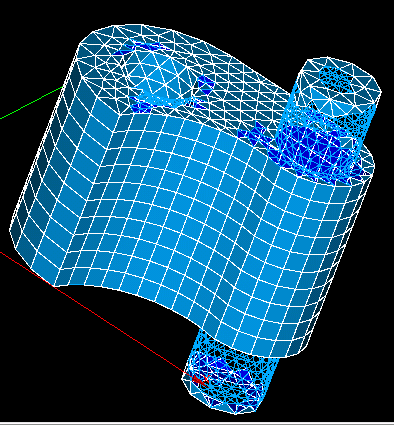
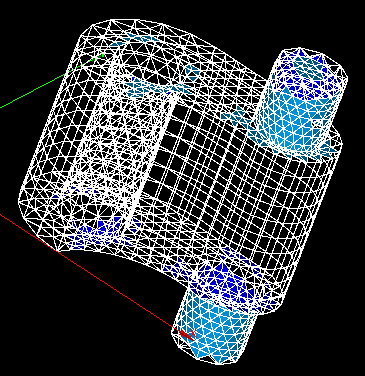
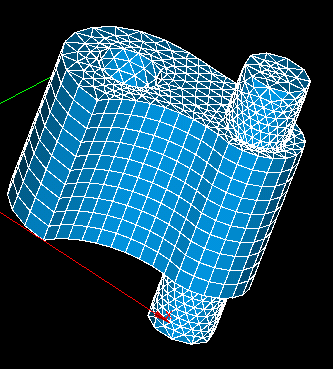
# Attention! This script has been written using the old approach basing on direct usage of SMESH idl interface.
# For the moment smesh package doesn't provide methods to create an intersection of two groups.
# In the next SALOME version the scripts will be updated to use only the commands from smesh package.
import SMESH
import SMESH_mechanic
smesh = SMESH_mechanic.smesh
mesh = SMESH_mechanic.mesh
salome = SMESH_mechanic.salome
aFilterMgr = smesh.CreateFilterManager()
# Criterion : AREA > 20
aFunctor = aFilterMgr.CreateArea()
aPredicate = aFilterMgr.CreateMoreThan()
aPredicate.SetNumFunctor(aFunctor)
aPredicate.SetMargin(20.)
aFilter = aFilterMgr.CreateFilter()
aFilter.SetPredicate(aPredicate)
anIds = aFilter.GetElementsId(mesh)
print "Criterion: Area > 20, Nb = ", len(anIds)
# create a group by adding elements with area > 20
aGroup1 = mesh.CreateGroup(SMESH.FACE, "Area > 20")
aGroup1.Add(anIds)
# Criterion : AREA < 60
aFunctor = aFilterMgr.CreateArea()
aPredicate = aFilterMgr.CreateLessThan()
aPredicate.SetNumFunctor(aFunctor)
aPredicate.SetMargin(60)
aFilter = aFilterMgr.CreateFilter()
aFilter.SetPredicate(aPredicate)
anIds = aFilter.GetElementsId(mesh)
print "Criterion: Area < 60, Nb = ", len(anIds)
# create a group by adding elements with area < 60
aGroup2 = mesh.CreateGroup(SMESH.FACE, "Area < 60")
aGroup2.Add(anIds)
# create an intersection of groups : 20 < area < 60
aGroup3 = mesh.IntersectGroups(aGroup1, aGroup2, "20 < Area < 60")
print "Criterion: 20 < Area < 60, Nb = ", len(aGroup3.GetListOfID())
salome.sg.updateObjBrowser(1)



# Attention! This script has been written using the old approach basing on direct usage of SMESH idl interface.
# For the moment smesh package doesn't provide methods to create a cut of two groups.
# In the next SALOME version the scripts will be updated to use only the commands from smesh package.
import SMESH
import SMESH_mechanic
smesh = SMESH_mechanic.smesh
mesh = SMESH_mechanic.mesh
salome = SMESH_mechanic.salome
aFilterMgr = smesh.CreateFilterManager()
# Criterion : AREA > 20
aFunctor = aFilterMgr.CreateArea()
aPredicate = aFilterMgr.CreateMoreThan()
aPredicate.SetNumFunctor(aFunctor)
aPredicate.SetMargin(20.)
aFilter = aFilterMgr.CreateFilter()
aFilter.SetPredicate(aPredicate)
anIds = aFilter.GetElementsId(mesh)
print "Criterion: Area > 20, Nb = ", len(anIds)
# create a group by adding elements with area > 20
aGroupMain = mesh.CreateGroup(SMESH.FACE, "Area > 20")
aGroupMain.Add(anIds)
# Criterion : AREA < 60
aFunctor = aFilterMgr.CreateArea()
aPredicate = aFilterMgr.CreateLessThan()
aPredicate.SetNumFunctor(aFunctor)
aPredicate.SetMargin(60.)
aFilter = aFilterMgr.CreateFilter()
aFilter.SetPredicate(aPredicate)
anIds = aFilter.GetElementsId(mesh)
print "Criterion: Area < 60, Nb = ", len(anIds)
# create a group by adding elements with area < 60
aGroupTool = mesh.CreateGroup(SMESH.FACE, "Area < 60")
aGroupTool.Add(anIds)
# create a cut of groups : area >= 60
aGroupRes = mesh.CutGroups(aGroupMain, aGroupTool, "Area >= 60")
print "Criterion: Area >= 60, Nb = ", len(aGroupRes.GetListOfID())
salome.sg.updateObjBrowser(1)
